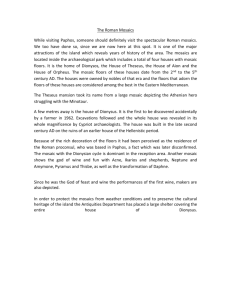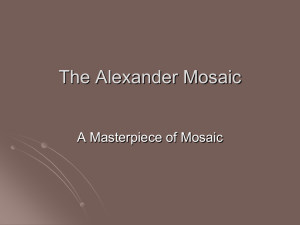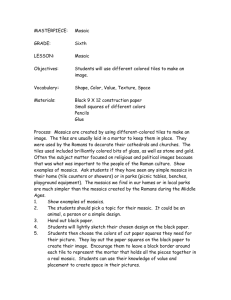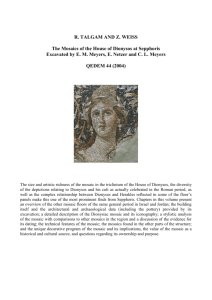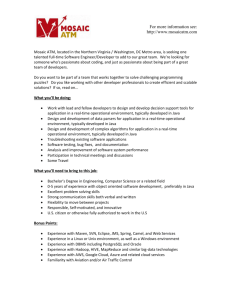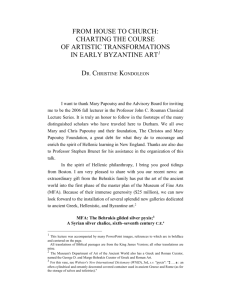Creating a Mosaic about Ancient Rome
advertisement
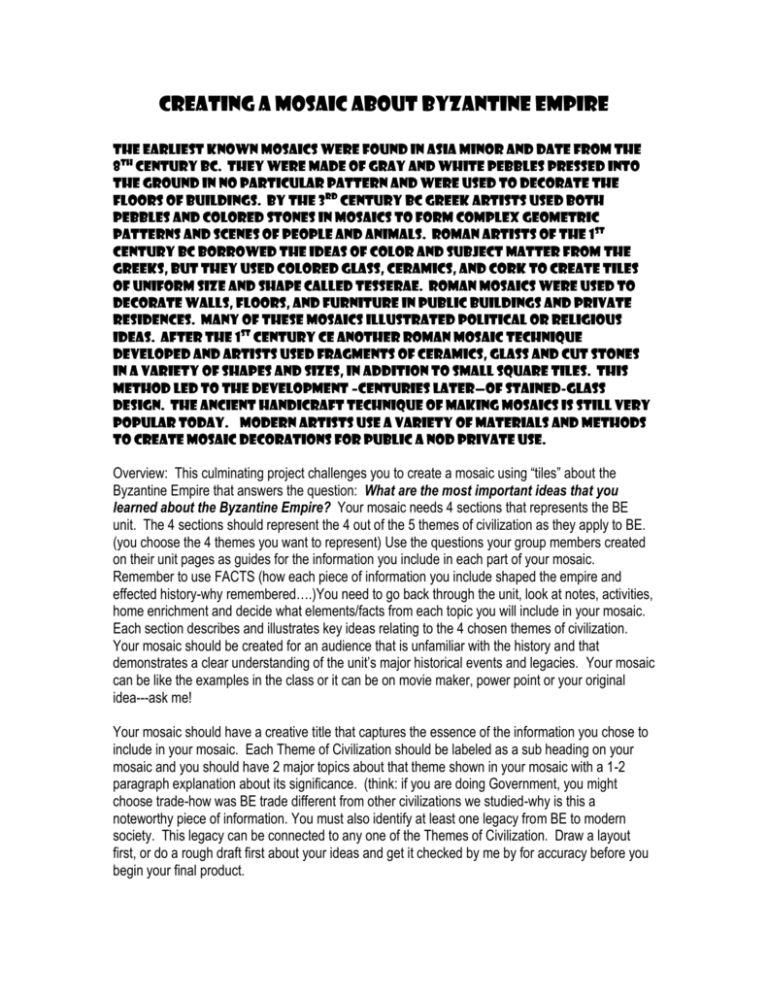
Creating a Mosaic about Byzantine Empire The earliest known mosaics were found in Asia Minor and date from the 8th century BC. They were made of gray and white pebbles pressed into the ground in no particular pattern and were used to decorate the floors of buildings. By the 3rd century BC Greek artists used both pebbles and colored stones in mosaics to form complex geometric patterns and scenes of people and animals. Roman artists of the 1st century bc borrowed the ideas of color and subject matter from the Greeks, but they used colored glass, ceramics, and cork to create tiles of uniform size and shape called tesserae. Roman mosaics were used to decorate walls, floors, and furniture in public buildings and private residences. Many of these mosaics illustrated political or religious ideas. After the 1st century CE another Roman mosaic technique developed and artists used fragments of ceramics, glass and cut stones in a variety of shapes and sizes, in addition to small square tiles. This method led to the development –centuries later—of stained-glass design. The ancient handicraft technique of making mosaics is still very popular today. Modern artists use a variety of materials and methods to create mosaic decorations for public a nod private use. Overview: This culminating project challenges you to create a mosaic using “tiles” about the Byzantine Empire that answers the question: What are the most important ideas that you learned about the Byzantine Empire? Your mosaic needs 4 sections that represents the BE unit. The 4 sections should represent the 4 out of the 5 themes of civilization as they apply to BE. (you choose the 4 themes you want to represent) Use the questions your group members created on their unit pages as guides for the information you include in each part of your mosaic. Remember to use FACTS (how each piece of information you include shaped the empire and effected history-why remembered….)You need to go back through the unit, look at notes, activities, home enrichment and decide what elements/facts from each topic you will include in your mosaic. Each section describes and illustrates key ideas relating to the 4 chosen themes of civilization. Your mosaic should be created for an audience that is unfamiliar with the history and that demonstrates a clear understanding of the unit’s major historical events and legacies. Your mosaic can be like the examples in the class or it can be on movie maker, power point or your original idea---ask me! Your mosaic should have a creative title that captures the essence of the information you chose to include in your mosaic. Each Theme of Civilization should be labeled as a sub heading on your mosaic and you should have 2 major topics about that theme shown in your mosaic with a 1-2 paragraph explanation about its significance. (think: if you are doing Government, you might choose trade-how was BE trade different from other civilizations we studied-why is this a noteworthy piece of information. You must also identify at least one legacy from BE to modern society. This legacy can be connected to any one of the Themes of Civilization. Draw a layout first, or do a rough draft first about your ideas and get it checked by me by for accuracy before you begin your final product. Mosaic Project Evaluation: Names: Quality of Historic Content: (55pts) Student Assessment Teacher Assessment *Key ideas selected show an overall Understanding of BE Vocabulary words are highlighted and Defined. Dates and time periods are Included. Historical people are noted /15 /15 * Each topic is described accurately Using examples to thoroughly illustrate Knowledge /20 /20 *The importance of each idea is clearly Explained. The theme is evident /10 /10 One legacy and information explaining how It is used today in the modern world. Need to cite /10 /10 * Visual and written information are Laid out in an organized manner. /5 /5 * Visuals clearly illustrate key historical Information, symbols are used /5 /5 * Color and creative touches make mosaic Visually appealing. /5 /5 * Each visual has written information about Its significance to BE, identifying it /10 /10 *Writing contains proper punctuation Spelling and grammar /5 /5 *Writing is clear and understandable to an Audience unfamiliar with the history of BE /10 /10 *Information is analyzed and synthesize well. Vocabulary, summary and information Are succinct and thematic /10 /10 TOTAL /105 Visual Appeal: (25) Writing Mechanics: (25) /105




